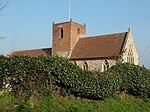Oulton Broad
Civil parishes in SuffolkEast Suffolk (district)EngvarB from June 2016LowestoftSuffolk Broads ... and 1 more
Waveney District

Oulton Broad refers to both the lake and the suburb of Lowestoft in the English county of Suffolk. The suburb is located 2 miles (3.2 km) west of the centre of Lowestoft. It became a civil parish in 2017. It had an estimated population of 10,338 at the 2011 United Kingdom census.
Excerpt from the Wikipedia article Oulton Broad (License: CC BY-SA 3.0, Authors, Images).Oulton Broad
The Boulevard, East Suffolk Oulton Broad
Geographical coordinates (GPS) Address Nearby Places Show on map
Geographical coordinates (GPS)
| Latitude | Longitude |
|---|---|
| N 52.474 ° | E 1.71 ° |
Address
The Boulevard
The Boulevard
NR33 9JS East Suffolk, Oulton Broad
England, United Kingdom
Open on Google Maps









